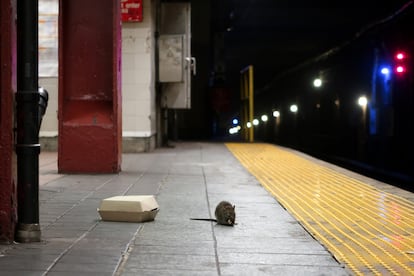The rat scourge tarnishing New York’s image and post-Covid recovery
The Big Apple is hoping to revive the economy and lure back tourists, but the record-high number of sightings are hurting these efforts


New York’s efforts to bounce back from the Covid-19 pandemic have come up against a surprising hurdle: rats. The combination of large amounts of waste and high temperatures, which overheat trash bags on the sidewalks, have brought out the vermin to the streets in unprecedented numbers, raising concerns for public health. Now, they are no longer just found in the subway, their traditional stronghold, but also in children’s playgrounds, the paths of Central Park – where it is difficult to distinguish them from squirrels – and, in dog parks, as shown in a video that went viral on social media two weeks ago. In the video, a group of dogs plays happily with something that looks like a ball, pushing it with their paws and throwing it into the air several times, until the bundle falls and runs away. It was a giant-sized rat.
The pandemic not only pushed the rodents into the street in search of food, it also emboldened them – in 2020 the US Centers for Disease Control and Prevention (CDC) warned that rats may become more “aggressive” due to the lockdown. Deprived of leftover food from restaurants, closed due to the Covid-19 restrictions at the start of the pandemic, more rats were forced to the surface to hunt. When sidewalk cafes and restaurants were allowed to reopen, diners found themselves being harassed by scavenging rats. The problem became so bad that restaurant owners had to create raised platforms for outdoor diners. The boom of al fresco dining – which was vital for the survival of the hospitality industry – and the reactivation of the construction sector – which often deprives entire rat populations of shelter – have aggravated the problem. As summer arrives and the heat escalates, there is concern that the city will lose its battle against the rats – just when the Big Apple is trying to sell itself as an attractive tourist destination.
They’re running over our feet. They’re dashing out in front of us as we walkMark Levine, president of the Manhattan Borough
“There’s no doubt that one factor is the resumption of construction,” said Mark Levine, president of the Manhattan Borough, on May 27. That day, the New York City councilor for city planning introduced a local bill that would require applicants for some construction permits to confirm they have employed a pest management professional for their projects. “I’ve never seen so many rats in my life,” said Levine. “They’re running over our feet. They’re dashing out in front of us as we walk. They’re climbing into trash cans on the corners.”
“This is about more than just aesthetics. We’ve had rats that are going into cars and eating out electrical cables. We have rats that are entering homes,” he said, adding that the rodents also transmit diseases. Last year, 15 cases of the bacterial disease leptospirosis were diagnosed, one of which was fatal.
Rats scurrying across the streets of New York is nothing new. In 2014, the Big Apple was named the “worst city in the world” due to its big rat population. As a result, most New Yorkers have the name of a pest controller in their contact lists. But not even pest control specialists have been able to curb the rat population that seems, at times, to dominate the public space. The aftermath of the pandemic could not be more unpleasant.
“Rats have taken up residence in the engine of my old Subaru and have left a trail of droppings and stench,” Richard Gehr, a resident of the Upper West Side, told EL PAÍS. “I don’t know where I can clean the engine, because if it’s already difficult to remove them [rats] from the streets, imagine trying to remove them from inside a hood. The problem is out of control, especially around restaurant outdoor dining areas, which are a magnet for them.”
Joanne, who lives near Central Park, also complained of similar problems. “There is a plague on my street. I think they have a nest in an empty building. Just last night there were about a dozen by my front door,” she said. “I have informed the City Council and asked the homeowners association to address the issue, to put on pressure, because in the 25 years I have been living here, I had not seen anything as bad.”
Meanwhile, neighborhood groups on social media are exchanging tips about how to repel rats away from their properties, including using homemade mint sprays or coffee grounds, which are allegedly scents that rats hate. As one pest controller worker explained to EL PAÍS: “Rat poison is prohibited, there are other methods.”
In the first five months of 2022, the number of rat sightings is the highest it has been since 2010, when the city began recording rodent complaints. Reports to the municipal helpline have increased by more than 70% since 2020, according to data from the City Council.
Three years ago, New York City touted a high-tech rat trap as the answer to the rat problem. But even this contraption – which lures the rats in with peanut butter Oreo cookies – has been unable to curb the infestation. The mayor of New York, Eric Adams, praised the rat trap back in 2019, when he was the president of the Brooklyn borough, but it’s unknown whether he still thinks it will be effective against the current scourge.
In the meantime, unemployment in New York City is double the national rate, and only 38% of workers in the financial district of Manhattan have returned to the office, and of this figure, only 8% go in five days a week. The city is betting on tourism to revive the economy, but the rat infestation has taken the shine off what many consider to be the city of cities – an opinion the rodents seem to share.
Tu suscripción se está usando en otro dispositivo
¿Quieres añadir otro usuario a tu suscripción?
Si continúas leyendo en este dispositivo, no se podrá leer en el otro.
FlechaTu suscripción se está usando en otro dispositivo y solo puedes acceder a EL PAÍS desde un dispositivo a la vez.
Si quieres compartir tu cuenta, cambia tu suscripción a la modalidad Premium, así podrás añadir otro usuario. Cada uno accederá con su propia cuenta de email, lo que os permitirá personalizar vuestra experiencia en EL PAÍS.
¿Tienes una suscripción de empresa? Accede aquí para contratar más cuentas.
En el caso de no saber quién está usando tu cuenta, te recomendamos cambiar tu contraseña aquí.
Si decides continuar compartiendo tu cuenta, este mensaje se mostrará en tu dispositivo y en el de la otra persona que está usando tu cuenta de forma indefinida, afectando a tu experiencia de lectura. Puedes consultar aquí los términos y condiciones de la suscripción digital.
More information
Archived In
Últimas noticias
Most viewed
- Reinhard Genzel, Nobel laureate in physics: ‘One-minute videos will never give you the truth’
- Oona Chaplin: ‘I told James Cameron that I was living in a treehouse and starting a permaculture project with a friend’
- Pablo Escobar’s hippos: A serious environmental problem, 40 years on
- Charles Dubouloz, mountaineering star, retires at 36 with a farewell tour inspired by Walter Bonatti
- Why we lost the habit of sleeping in two segments and how that changed our sense of time










































